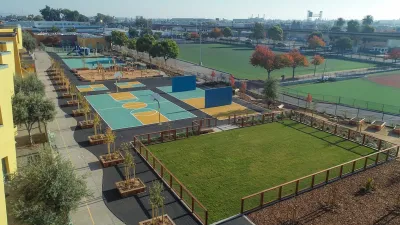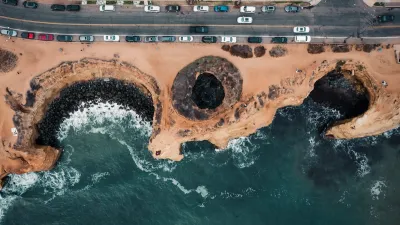Chicago is using pervious pavements and reflective materials on its 1,900 miles of alleys to reduce flooding, cut demand on storm sewers, and decrease the city's urban heat island effect. The program is so successful that they are expanding it.
Back in 2004, Chicago's Department Of Transportation had no concept of how to build roads and alleys using pervious materials.
Janet L. Attarian writes, "To overcome this obstacle, the department led an aggressive design and investigative process that involved collecting best practices and sample specifications from around the country. CDOT developed its own specifications through a collaborative process involving CDOT staff, the design team, and a materials testing consultant. Together, they established a series of goals, tested the ideas in a laboratory, and then reviewed the results until the final mix designs, materials, and methods were solidified."
The DOT embarked on a number of pilot projects to test out their new-found knowledge, detailed in the full article.
Thanks to Triskele Jim
FULL STORY: Greener Alleys

Manufactured Crisis: Losing the Nation’s Largest Source of Unsubsidized Affordable Housing
Manufactured housing communities have long been an affordable housing option for millions of people living in the U.S., but that affordability is disappearing rapidly. How did we get here?

Americans May Be Stuck — But Why?
Americans are moving a lot less than they once did, and that is a problem. While Yoni Applebaum, in his highly-publicized article Stuck, gets the reasons badly wrong, it's still important to ask: why are we moving so much less than before?

Using Old Oil and Gas Wells for Green Energy Storage
Penn State researchers have found that repurposing abandoned oil and gas wells for geothermal-assisted compressed-air energy storage can boost efficiency, reduce environmental risks, and support clean energy and job transitions.

Updating LA’s Tree Rules Could Bring More Shade to Underserved Neighborhoods
A new USC study finds that relaxing Los Angeles’ outdated tree planting guidelines could significantly expand urban tree canopy and reduce shade disparities in lower-income neighborhoods, though infrastructure investments are also needed.

California's Canal Solar Projects Aim to Conserve Resources and Expand Clean Energy
California’s Project Nexus has begun generating electricity from solar panels installed over irrigation canals, with researchers and state agencies exploring statewide expansion to conserve water and boost clean energy production.

HHS Staff Cuts Gut Energy Assistance Program
The full staff of a federal program that distributes heating and cooling assistance for low-income families was laid off, jeopardizing the program’s operations.
Urban Design for Planners 1: Software Tools
This six-course series explores essential urban design concepts using open source software and equips planners with the tools they need to participate fully in the urban design process.
Planning for Universal Design
Learn the tools for implementing Universal Design in planning regulations.
Heyer Gruel & Associates PA
City of Moreno Valley
Institute for Housing and Urban Development Studies (IHS)
City of Grandview
Harvard GSD Executive Education
Salt Lake City
NYU Wagner Graduate School of Public Service
City of Cambridge, Maryland





























